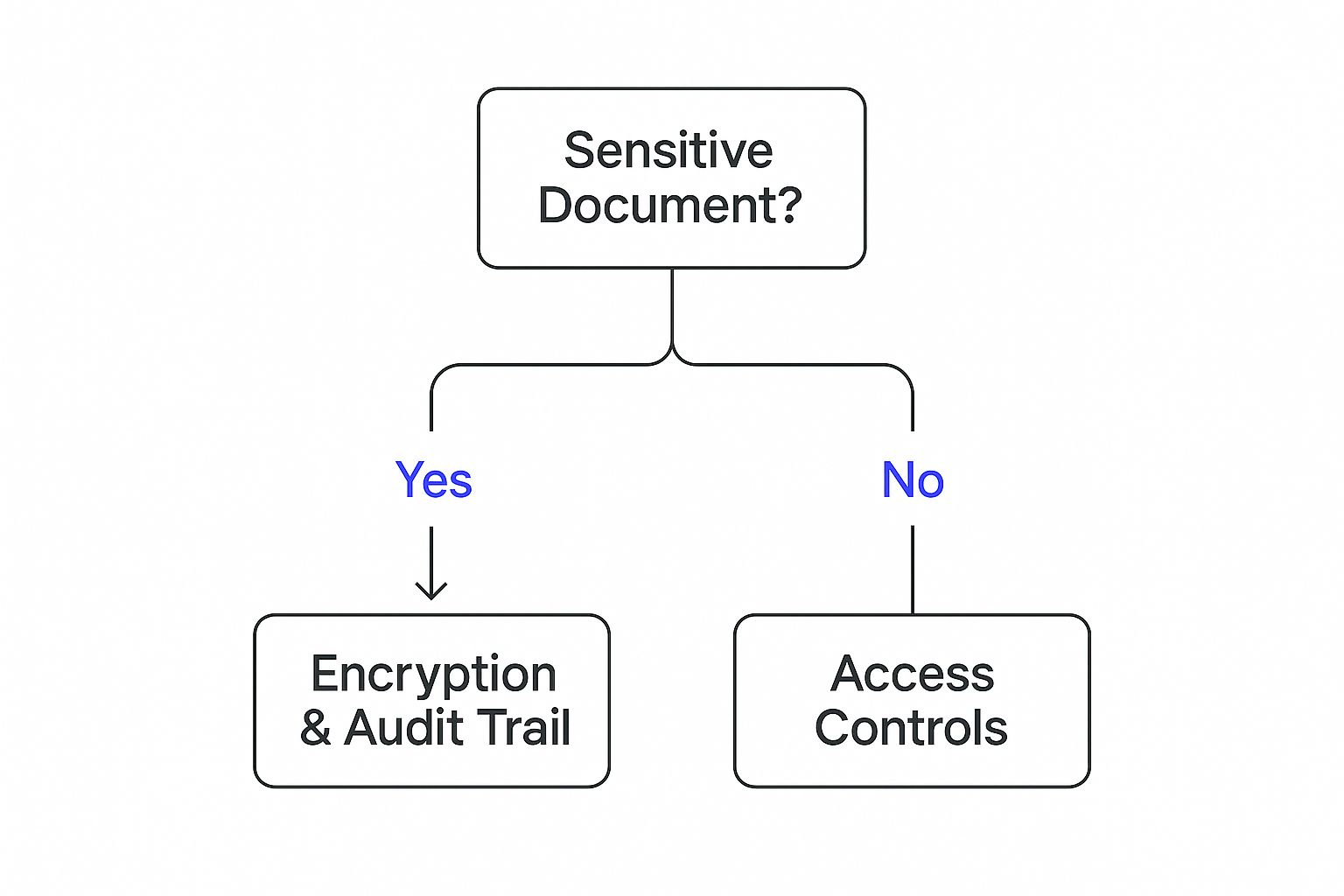
When Paper Becomes Your Biggest Enemy
Imagine this: It's midnight. A crucial hearing looms just hours away. Sarah, a partner at a mid-sized firm, is frantically sifting through mountains of paper crammed into overflowing filing cabinets. She’s desperate to find a critical document, one that could make or break her case. This scenario, unfortunately, plays out in law firms across the country, costing firms time, money, and even cases.
This isn’t just about cluttered desks; it’s a fundamental challenge in today's legal world. The struggle to manage documents translates into tangible costs that impact a firm's bottom line. Think about the billable hours lost to searching for misplaced files. Consider the damage to client relationships and reputation caused by missed deadlines. And what about the toll on your team's morale as they grapple with constant frustration and stress? These hidden costs can quietly erode a firm's success.
Traditional document handling isn’t just outdated; it's a genuine liability. Misplaced evidence can derail a case. A missed filing deadline can have devastating consequences. These aren’t just hypothetical scenarios; they're real risks that can threaten a firm’s viability. For example, firms struggling with document management often face higher malpractice insurance premiums. They also find it harder to attract and retain top legal talent.
This is precisely why document management for law firms is so vital. Moving to digital solutions is no longer a "nice-to-have" but a necessity. The legal profession is increasingly turning to technology to address these challenges. In fact, as of 2025, 17.4% of law firms are prioritizing improvements to their document management through technology, including specialized legal document management software. This shift reflects a growing awareness of the importance of efficient and secure document handling. The trend is further underscored by the fact that 54% of legal professionals now use AI to draft correspondence, demonstrating how technology is becoming integrated into everyday legal tasks. Discover more insights on the use of technology in law firms.
Ineffective document management has a ripple effect, impacting everything from client satisfaction to a firm’s profitability. It's time to shift our perspective. Document management isn't just a back-office issue; it's a strategic lever for success. It's not about simply organizing files; it's about building a strong foundation for growth and resilience in a demanding legal market. In the next section, we'll explore how these systems work, breaking down complex concepts into easy-to-understand ideas.
Understanding Legal Document Systems Like Your Phone

Remember how intimidating smartphones seemed at first? Now we can barely function without them. Document management for law firms is going through a similar evolution. What was once a source of confusion is becoming an intuitive, essential tool. Think of it as trading your rotary phone for a smartphone, but for all your legal paperwork.
Deconstructing the Digital Filing Cabinet
Let's break down how these systems work, using relatable examples whether you're a tech expert or still battling with your printer. First, consider cloud storage. Imagine a dedicated assistant who flawlessly organizes and protects every document, around the clock. That’s essentially what the cloud offers. Your files reside in a secure digital vault, accessible from anywhere with internet access. This eliminates bulky filing cabinets and the frantic searches that accompany them.
Now, picture version control as a time machine for your documents. You can revisit past versions of a file, see who made what changes, and even revert to earlier drafts. This eliminates the confusion of multiple versions circulating and ensures everyone works with the most current information. It’s like having a detailed history of your document's journey.
Finally, think of search functionality as your personal research librarian with a perfect memory. Modern document management systems use powerful search tools that can pinpoint specific documents in seconds, even across massive databases. You can search by keywords, dates, client names, or any other criteria, eliminating hours of sifting through physical files. This instant access lets you respond to client requests quickly and prepare for hearings efficiently.
From Confusion to Clarity: Building Your Understanding
These seemingly complex systems are built upon these core concepts. By understanding these functions – cloud storage, version control, and advanced search – you’ll grasp the power of document management. These systems aren't just about digitizing paper; they create a streamlined, efficient, and secure foundation for your entire practice.
This efficiency directly translates to cost savings. Studies show that firms with effective document management systems can reduce document-related costs by as much as 30%. It also empowers your team. Imagine your paralegals freed from tedious filing, focusing on strategic work. Picture your attorneys confidently accessing key documents in client meetings. This is the transformative potential of document management.
To further understand the different types of document management systems available, let's look at a comparison of cloud-based and on-premise solutions.
The following table outlines the key differences and helps determine which option best suits your firm's needs.
Cloud vs. On-Premise Document Management Comparison A detailed comparison of cloud-based and on-premise document management solutions for law firms, covering costs, security, accessibility, and maintenance requirements.
| Feature | Cloud-Based | On-Premise | Best For |
|---|---|---|---|
| Cost | Subscription-based (typically monthly or annual) | Higher upfront cost for hardware and software, plus ongoing maintenance | Firms with predictable budgets and limited IT resources / Firms with large IT budgets and a need for maximum control |
| Security | Managed by the provider, often with advanced security measures | Requires in-house security management and expertise | Firms comfortable with outsourcing security / Firms requiring complete control over security |
| Accessibility | Access from anywhere with internet connection | Access limited to the local network | Firms with remote workers or multiple offices / Firms with strict data location requirements |
| Maintenance | Automatic updates and maintenance handled by the provider | Requires dedicated IT staff for maintenance and updates | Firms with limited IT staff / Firms with dedicated IT resources |
| Scalability | Easily scalable by adjusting the subscription | Requires significant hardware upgrades for scaling | Growing firms or those with fluctuating needs / Firms with stable size and predictable needs |
| Backup and Disaster Recovery | Automated backups and disaster recovery included | Requires setting up and managing backups and disaster recovery plans | Firms prioritizing ease of backup and recovery / Firms needing granular control over backup and recovery |
Key takeaways from the comparison: Cloud-based solutions offer convenience and scalability, while on-premise solutions provide greater control over data and security. The best choice depends on your firm's specific needs and priorities.
In the next section, we’ll explore the tangible benefits of these systems, going beyond technical details to examine the real-world impact on your law firm.
The Transformation That Changes Everything

More than just a filing system, a modern document management system (DMS) can truly reshape a law firm. Think of it like upgrading from a cluttered, overflowing filing cabinet to a sleek, searchable digital library. Consider David, whose 15-attorney firm was buried under paper. Implementing the right DMS transformed his firm into an industry leader. His story isn't unusual. Firms of all sizes are experiencing real improvements in client satisfaction, profitability, and even attorney well-being.
From Scrambling to Confident: Client Meetings Reimagined
Imagine walking into a client meeting completely prepared, instantly pulling up any document with a few clicks. No more frantic searches for misplaced files, just smooth, confident presentations that impress clients and win cases. This seamless access builds trust and projects an image of professionalism, strengthening client relationships and boosting your firm's reputation.
This readily available information also means more productive client meetings. Attorneys can quickly address client questions, review key documents together, and make informed decisions on the spot. This efficiency saves valuable time and shows a real commitment to client service.
Empowering Your Paralegals: Automating for Strategic Advantage
Automated workflows within a DMS are another significant advantage. Imagine your paralegals freed from endless administrative tasks, instead focusing on strategic work that directly contributes to winning cases. This not only boosts efficiency, it elevates the paralegal's role within the firm.
This shift allows paralegals to apply their skills to legal research, case preparation, and client communication. They become key players in achieving positive case outcomes, maximizing their value to the firm and increasing their own job satisfaction.
Collaboration Without Boundaries: Seamless Teamwork, Anywhere
The right DMS transforms collaboration. Think of it as a virtual conference room, accessible anytime, anywhere. Whether your team is across the hall or across the country, everyone can access, edit, and share documents in real time, ensuring everyone is on the same page. This eliminates delays and creates a more cohesive and productive work environment.
This real-time collaboration also extends to clients and external parties. Secure document sharing portals make communication and information exchange easy, streamlining workflows and keeping everyone up-to-date. This transparency builds trust and improves communication throughout the entire legal process.
Security That Prevents Disasters: Real-World Protection
Security is more than just a technical feature; it’s essential for preventing malpractice. Proper access controls and audit trails have saved firms from disaster countless times. Think about the potential fallout from a data breach involving confidential client information. A robust DMS guards against these risks, protecting your firm’s reputation and financial well-being.
The legal document management software market has seen substantial growth, driven by increasingly complex regulations and the need for powerful collaboration tools. In 2024, the market was valued at $2.6 billion, and it’s projected to reach $3.01 billion by 2025, a 15.7% compound annual growth rate (CAGR). Discover more insights into the growth of the legal document management software market. This growth reflects the growing awareness that secure and efficient document management is no longer optional but essential for law firms.
In the next section, we'll discuss the intricacies of managing evidence in the digital age, from traditional paper documents to electronic communications.
Solving The Modern Evidence Puzzle

Think of today's legal world as a massive, sprawling jigsaw puzzle. Each piece of information – emails, texts, social media posts, videos – is a tiny piece of the larger picture. This is the reality of digital evidence. Document management for law firms isn't just about filing cabinets anymore. It's about managing this complex digital puzzle. A single case might involve Microsoft Word documents, WhatsApp chats, endless email chains, video files, and even TikTok posts.
Navigating the Digital Data Deluge
This shift to digital evidence presents new challenges. Imagine trying to make sense of thousands of text messages, each a tiny fragment of a story. How do you keep the context clear? How do you avoid missing that one crucial text buried within a massive thread? That seemingly insignificant message could be the key to the entire case.
The sheer variety of platforms and formats adds another layer of difficulty. Extracting data from Slack, Microsoft Teams, and other platforms, ensuring its admissibility in court, and maintaining a clear chain of custody – these are just a few of the hurdles legal teams now face. Traditional methods simply aren't enough.
This digital shift demands adaptation. Law firms are wrestling with the growing volume and complexity of data in document review. Electronically stored information (ESI), including short, quick messages from various platforms, adds to the challenge. Learn more about the challenges law firms face in document review. Success requires both tech skills and sharp legal minds.
From Chaos to Clarity: Real-World Success Stories
Some firms have cracked the code of this digital transformation. Let's look at how they've tackled huge document reviews with diverse data types. One firm, facing a case with over 50,000 emails and texts, used an AI-powered review platform. It slashed review time and uncovered hidden connections in the data.
But the path isn't always smooth. Some firms have struggled. One, overwhelmed by the sheer volume of data in a complex case, faced delays and soaring costs because its document management processes weren’t up to par. These stories show the vital importance of planning and investing in the right tools and training.
The Rise of AI: A New Era in Evidence Management
AI-powered tools are essential for processing the mountains of data in modern cases. They can quickly analyze vast amounts of information, pinpoint key documents, and even predict case outcomes.
But human judgment is still crucial. AI can process and organize, but lawyers are needed to interpret the data, apply legal reasoning, and craft winning strategies. The combination of AI and human expertise is the new standard, allowing firms to handle increasingly complex cases efficiently. In the next section, we'll explore how to choose the right document management system, navigating the confusing world of vendors and features.
Choosing Your System Without The Sales Pitch

This decision tree helps visualize the security compliance considerations you'll need to make when choosing a document management system. It starts with a simple question: how sensitive are your documents? As the diagram shows, highly sensitive information needs encryption and a solid audit trail. Less sensitive files might be fine with standard access controls. Understanding this early on is key to finding a system that truly fits your firm's security needs.
Picking the right document management system can feel like navigating a minefield. Vendors often make every system sound amazing, but how do you cut through the noise? Think of it like buying a car. You wouldn't choose one based on a flashy commercial alone. You’d check its features, consider your budget, and think about your specific driving needs. Choosing a document management system is similar.
Asking the Right Questions: Beyond the Demo Dazzle
First, take stock of your firm’s needs. What are your current frustrations? Are you buried under mountains of paper? Is collaborating a nightmare? Are security breaches keeping you up at night? Once you know your challenges, you can evaluate systems based on practical criteria, not marketing fluff. Our guide on legal document management systems offers a deeper look at these factors.
Next, consider the hidden costs. Vendors often downplay the expense of training, which can sometimes double your initial investment. Integrating the new system with your existing software can also cause unexpected delays and headaches. Ask tough questions upfront. How much training is included? What integration challenges have other firms faced? Talking to other firms about their experiences can be incredibly valuable.
Scalability: Thinking Long-Term
Consider your firm’s future. A system that works for a solo practitioner might crumble under the weight of a 50-attorney firm. Scalability is crucial. Can the system grow with you? Can it handle increasing amounts of data and users without slowing down or crashing? These are essential questions.
Before we move on, let's look at a helpful tool to guide your evaluation:
Document Management System Feature Evaluation Matrix
A comprehensive evaluation framework covering essential features, security requirements, integration capabilities, and cost considerations for law firms
| Feature Category | Essential | Nice to Have | Evaluation Criteria | Weight |
|---|---|---|---|---|
| Security | Encryption, Access Controls, Audit Trail | Two-Factor Authentication, Intrusion Detection | Data Protection, Compliance | High |
| Search | Keyword Search, Metadata Search | Full-Text Search, OCR | Speed, Accuracy | High |
| Integration | Existing Case Management System, Email | Calendar, Billing Software | Seamless Data Flow, Efficiency | Medium |
| Collaboration | Document Sharing, Version Control | Co-Editing, Real-Time Updates | Teamwork, Productivity | Medium |
| Cost | Subscription Fee, Implementation Costs | Training, Customization | ROI, Budget | High |
This matrix helps you weigh different features based on their importance to your firm. Remember, "essential" features are non-negotiable, while "nice-to-have" features add value but aren't crucial.
The Business Case: Convincing the Partners
To secure the necessary budget, you need a strong business case. Focus on the return on investment. How will the system save time and money? How will it improve client service and boost attorney morale? Use data whenever possible. For example, calculate how much time your team spends searching for documents and the potential time savings with a new system. This data-driven approach can help convince even the most skeptical partners.
User Adoption and Beyond
Remember, technology is only as effective as the people using it. User adoption is paramount. Choose an intuitive and user-friendly system. Provide thorough training and ongoing support. Data migration, the process of transferring existing files to the new system, can be complex. Plan carefully and dedicate sufficient resources. Don't forget ongoing maintenance. Factor in the costs of updates, support, and future system upgrades.
By asking the right questions, understanding hidden costs, and focusing on practical needs, you can choose a document management system that truly serves your firm, now and in the future. It’s about finding the perfect fit for your practice, not just buying the latest gadget.
Implementation That Actually Succeeds
Think of implementing new software like building a house. You can have the best blueprints in the world, but without a skilled construction crew and a well-managed project, you’re likely to end up with a disaster. Software implementations in law firms are no different. The legal world is littered with stories of failed and costly tech rollouts. Often, the difference between success and an expensive headache isn’t the software itself, but how it’s implemented. Let’s explore what successful firms do differently, learning from both their triumphs and the costly lessons of those who stumbled along the way.
Step-by-Step: Minimizing Disruption, Maximizing Adoption
Successful document management for law firms starts with a well-defined process. Imagine a detailed roadmap, guiding you from the initial evaluation all the way to launch day and beyond. This plan should outline clear milestones, assign responsibilities, and establish how everyone will communicate throughout the project. It's your navigation system, ensuring you don't get lost on the journey.
Next, getting everyone on board is crucial. Many partners have seen technology projects fail to deliver, leading to skepticism. Addressing their concerns directly is key. Explain the system's advantages – how it will boost efficiency, save money, and improve client service. A pilot program can be especially valuable, demonstrating the system’s benefits in a controlled environment before a firm-wide rollout.
Finally, effective training is essential. Busy attorneys don't have time for long, drawn-out tutorials. Short, focused sessions tailored to specific workflows are far more effective. Hands-on practice and easy-to-access support are vital for ensuring everyone feels comfortable and confident with the new system.
Change Management: Navigating the Legal Landscape
Change in a legal setting requires careful handling. Precision and client service are paramount, and transitions shouldn’t compromise either. Engage your team throughout the entire process. Ask for feedback, address any worries, and celebrate milestones achieved. This open communication fosters a sense of ownership and minimizes resistance to the new system.
Practical tools can also smooth the transition. A detailed implementation timeline keeps everyone informed about what to expect. A realistic budget breakdown helps manage expectations and prevents financial surprises. And a practical checklist ensures all the critical steps are covered, from migrating data to training users.
Measuring Progress: Adapting to the Unexpected
Things rarely go exactly as planned. Regularly monitoring progress is crucial. Track important metrics like user adoption rates, how quickly documents can be retrieved, and client satisfaction scores. These measurements provide valuable insights into the system's effectiveness and pinpoint areas for improvement. Be flexible and ready to adjust your approach as needed. Adaptability is key to successful implementation.
You might be interested in: Legal Document Automation
It's important to have realistic expectations. Implementing a new document management system requires time and effort. There will inevitably be challenges. By anticipating potential roadblocks and having contingency plans, you can navigate these hurdles and ensure a smoother transition.
Building Your Firm’s Future: A Foundation for Success
Successfully implementing a document management system is about more than just the technology; it's about laying the groundwork for a more efficient, productive, and profitable future. It’s about giving your team the tools they need to excel and providing clients with outstanding service. It's about positioning your firm for success in a constantly changing legal landscape. In the next section, we’ll provide a concrete action plan – a clear roadmap for your firm's digital future.
Your Action Plan For Digital Success
So, we’ve talked a lot about document management systems. Now, how do you actually do this? How do you take all this information and make it work for your firm? Let's map out a practical path forward.
Assessing Your Current Reality: An Honest Look
Think of this like a doctor's visit. Before prescribing anything, they need to diagnose the problem. What are your firm’s document management headaches? Are you buried under mountains of paper? Is collaborating on documents like pulling teeth? Do you lie awake at night worrying about data breaches? Pinpointing these pain points is the first step to finding the right cure.
Setting Achievable Goals: From Vision to Reality
Once you know what’s wrong, you can set realistic goals. These shouldn't be vague aspirations. They need to be concrete and measurable. For example, instead of saying “we want better document management,” try “we want to cut document retrieval time in half within six months.” That kind of specific goal gives you something to aim for and a way to track your progress.
Building the Business Case: Getting Buy-In
Getting leadership on board often means showing them the bottom line. Think about the return on investment. How will a new system save time and money? Will it improve client service? Boost team morale? Put numbers to these benefits. For instance, calculate how much time (and money) is wasted hunting for documents. A data-driven approach makes your case much stronger. You might be interested in: 8 Best Practices for Legal Document Management.
Starting Small, Scaling Up: The Pilot Program Approach
A pilot program is like a test drive. You get to try out the new system with a small group before committing the whole firm. This lets you get feedback, iron out any kinks, and refine your approach. A successful pilot program can build excitement for the full rollout.
Measuring What Matters: Beyond Vanity Metrics
Focus on metrics that really matter, like how much faster you're finding documents, how happy your clients are, and how much you're saving on storage. These key performance indicators (KPIs) tell the real story. Don't get sidetracked by surface-level metrics that look impressive but don't reflect real improvement.
Overcoming Resistance: Addressing Common Fears
Change can be scary, especially in a field as traditional as law. Address people's concerns directly. Explain the benefits clearly and patiently. Offer plenty of training and support. Acknowledge the learning curve, but emphasize the long-term gains. Open communication and a supportive atmosphere are essential.
The Big Picture: Digital Transformation and the Future
Document management isn't an isolated upgrade. It’s part of a bigger shift towards digital transformation. A modern DMS sets the stage for adopting other new technologies, helping your firm thrive in a changing market. It makes it easier to integrate tools like client portals and LexisNexis for legal research.
Your Roadmap to Success: A Practical Framework
Think of this whole process as a journey. Here’s a simple framework to guide you:
- Assessment: Take stock of your current situation and pinpoint the challenges.
- Planning: Create a strategic plan with specific goals, a timeline, and a budget.
- Pilot: Run a pilot program to test the waters and gather feedback.
- Implementation: Roll out the new system firm-wide, with training and support.
- Evaluation: Track your progress and make adjustments as needed.
This cyclical process helps you constantly learn and improve your document management practices.
Ready to streamline your documents and transform your practice? Check out Legal Document Simplifier today!